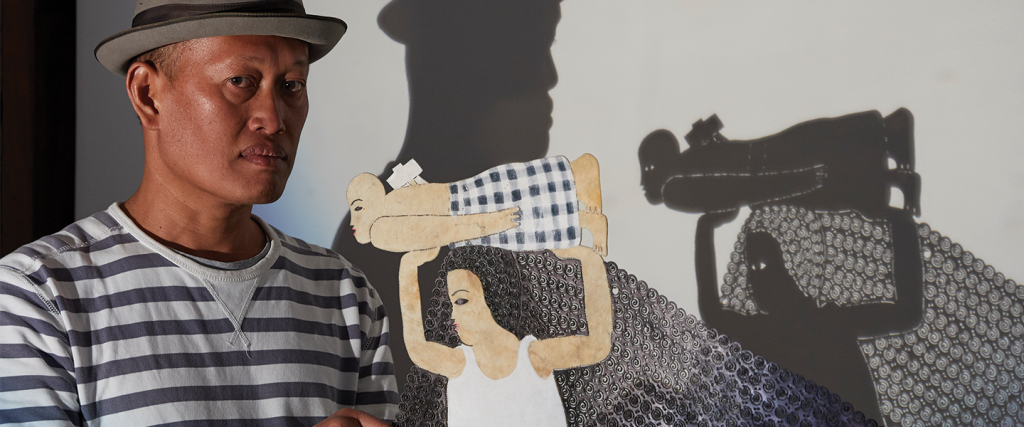My mother’s ancestors lived in Java and Sumatra. My Dad’s ancestors were convicts on the second fleet. Mum met Dad when he visited Java by way of Papua New Guinea in 1990. Mum was 26, Dad was 24 and the Indonesian nation state was 45 years old. Growing up in Tamworth, my culture was a mystery to me. I had hints like the cheap keris Dad smuggled into Australia or the Qur’an hidden in my Mum’s dresser drawer. However these were just objects to me – my parents couldn’t carry the knowledge needed to explain their meaning. Javanese and Bahasa Indonesia never crossed my tongue until I was an adult.
I have since moved to Canterbury-Bankstown and have a lot of cultural dots that need connecting. For me, an artist like Jumaadi is a gift from the heavens. A visual, installation and performance artist based out Sydney and Yogyakarta, Indonesian stories and traditions pervade each of his creations down to the Balinese rice-glue primer used to seal his textile drawings.
In the performance Island of Shadow, Jumaadi and the Shadow Factory tells stories of Indonesia’s troubled, turbid history. Specifically, the play seems to depict the Dutch conquest of the Banda Islands from 1609 to 1621. However this is not explicit and similar scenes could resonate with many events of the long and violent colonial occupation by the Dutch.
Stuffed into Mosman Art Gallery, an art space inside a repurposed church building — two overhead projectors and puppets of paper hide are set up to create the wayang. Jumaadi’s distinct, vertical-eyed characters and the ubiquitous pineapples translate well to the 2D shadow realm. With this apparatus, Jumaadi’s crew performs audio-visual alchemy. Transmuting pain into peace. Creating comedy from distress. The result is a work weaved with magic and play. And a chance to emotionally engage with painful stories of colonial conflict through the careful reflections of a skilled artist.
“Sitting behind the screen, I smoked too many kretek and tried not to fall asleep. The violent, metallic crashing of the gamelan occasionally startled me out of slumber as the puppets told the Ramayana and Mahabharata long into the night.”
The makeshift set up reminds me of when my cousin Mahmud and I visited the theatre inside Sasono Hinggil Dwi Abad in Yogyakarta. We were both 20. Sitting behind the screen, I smoked too many kretek and tried not to fall asleep. The violent, metallic crashing of the gamelan occasionally startled me out of slumber as the puppets told the Ramayana and Mahabharata long into the night. Meanwhile, Mahmud would murmur English in my ear, filling me in on the story: ‘Dronacharya is asking Arjuna why he practice shooting at night. Arjuna says if I can eat my dinner with no lamp, why I can’t shoot in the dark?’
The art gallery patrons shuffle into the building through a brick archway. Dim, late evening light filters through small stained glass windows. Musicians play some light hearted keroncong. In the band, led by Suwandi Widianto, I see a kebaya clad woman and a man wearing blangkon. The cak cuk of the feather-light strings bounces on and off the beat like a fighter on their toes. By the entrance, arranged on china plates waits an olfactory ambush of spices. Cumin, turmeric, clove, cinnamon, coriander seed and more. I imagine it would smell like a VOC trading post. The house lights dim and Jumaadi takes us to the Island of Shadow.
1627. The Dutch are here to stay and J.P. Coen is Governor General. Jumaadi styles this puppet with a long, Mr Burns-esque nose and lips that look like they’ve been pursed since the turn of the century. East Indies army stooges have patrol caps and are marked with chevrons. Other colonial soldiers have pale and ghoulish faces. In an early scene, a woman balancing a basket full of snake fruit on her head is approached by what looks like a plantation owner. He smokes a pipe and stands with one hand on his hip. The woman seems to go along the Dutch farmer, followed by more people holding pineapples. Before we know it, the Indonesian archipelago is criss-crossed with shipping routes like the roots and branches of a great banyan tree.
“The Dutch had the same plan wherever they went. Create and maintain a trade monopoly. Crush any opposition, European or local.”
From here Jumaadi tells a story that could have occurred on any island in Nusantara. The Dutch had the same plan wherever they went. Create and maintain a trade monopoly. Crush any opposition, European or local. Often the Dutch would work alongside Indonesian rulers who were willing to abuse their own people for profit. Other times they would exploit existing conflicts in an effort to divide and conquer.
The rest of the story plays out with a sense of comic parody. The pipe smoking farmer and an Indies soldier physically butt heads in disagreement, wrestling back and forth until they spill off the screen. Some things are hilariously out of scale, like a figure who carries a boat on their head and is bigger than an island. Or a soldier who literally steals a plot of land, holding it like a watermelon.
However, not all of it is comedy. When the situation inevitably turns to violence, the faces of angry spirits cover the screen and hideous figures lurch about on four limbs. A cloaked rebel brandishing two klewang confronts a Dutch soldier. Buildings are burned (orange cellophane) and blood is spilled (red cellophane). Monstrous corpses lay about, cleft by blades leaving wounds like crocodile jaws. Despite the grim images, the artist can always be trusted to resolve tensions in a safe and healing direction. The play ends with a song of gentle sorrow. I catch a lyric with my limited Bahasa Indonesia: Why do you cry, your eyes are swollen, oh Mama. Here, Jumaadi gives us space to sit with the grief. To tend to the wound of history’s harrowing truth. To mourn with love and intention.
One image has stuck most prominently in my mind: a dozen infants, connected by a sprawl of connected tree roots, sleeping under the soil. This image is inverted at the end of the shadowplay, disembodied heads with eyes closed rest in the same root like structure. To me it means that my ancestors are enmeshed with the ecology itself. It reminds me that no matter what occurs in the human world, their spirits wait for me in the arboreal and the unseen.

